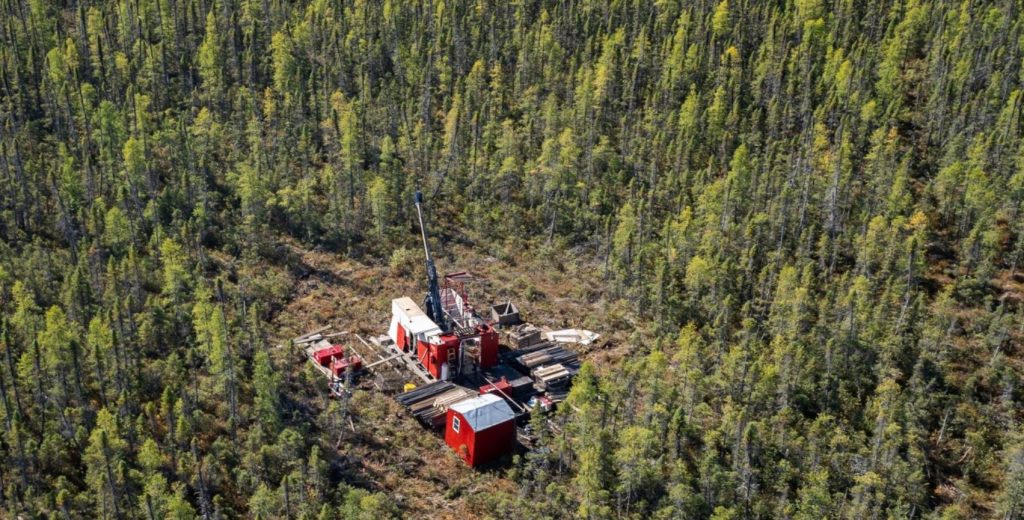Wallbridge Mining drills 1.17 g/t gold over 7.1 metres at Grasset, Quebec

Wallbridge Mining Company Ltd. [TSX-WM; OTCQX-WLBMF] reported final assay results of the inaugural 2023 drill program at its 100%-owned Grasset gold property, Quebec, which expanded the known gold mineralization discovered in the first holes reported on November 13, 2023.
Highlights: First drill program by Wallbridge on a prospective 20-kilometre strike length of the Sunday Lake deformation zone (SLDZ) at Grasset gold, identified multiple grassroots gold occurrences under glacial overburden cover.
Drilling along the northern contact of the SLDZ intersected gold mineralization in 12 of 20 holes over a five-kilometre strike length (Hinge zone, and targets G5 and G11) in a similar geologic setting to Agnico Eagle’s Detour Lake mine.
New assays received from the 2023 drill program expanded upon the gold mineralization previously reported within the Hinge zone (targets G1 and G2), with intervals including 12.11 grams per tonne (g/t) gold (Au) over 0.50 metre and 4.99 g/t Au over 1.20 metres.
“Grasset Gold covers approximately 20-km of strike length with favorable geology along the northern contact of the SLDZ, a similar setting to the company’s Fenelon and Martiniere Gold deposits and Agnico Eagle’s Detour Lake mine,” said Attila Pentek, Wallbridge’s Vice President, Exploration.
“We are encouraged by the widespread nature of gold mineralization intersected in 60% of the drill holes in our inaugural program on the property, especially given the 50 to 80 metres of overburden coverage. Today’s results build upon those of the previous news release and together highlight the contact of the Timiskaming-like conglomerate basin and the mafic volcanics, which now has been intersected over 5 km on the property, as an important control for gold mineralization. We are now continuing to evaluate structures which have the potential to host economic mineralization within this prospective environment.”
Hinge Zone (Targets G1 & G2): Results from holes GR-23-132, GR-23-133 and additional results for GR-23-130 further delineate the gold mineralization at the Hinge Zone, which was discovered by the first drill hole testing this target area, as reported in the Company’s news release dated November 13, 2023. The zone is hosted within Timiskaming-like sediments and mafic volcanics over a strike length of approximately 600 metres and at shallow depths starting at the bedrock surface. This mineralization is characterized by a broad envelope (up to 200 metres core length) of anomalous gold values with discrete higher grade intervals, like the 1.17 g/t Au over 7.10 metres, including 12.11 g/t Au over 0.50 m in GR-23-132, and 4.99 g/t Au over 1.20 metre in GR-23-133 reported today, and the previously released 1.22 g/t Au over 8.50 metres, including 3.20 g/t Au over 2.50 metres in GR-23-130.
Target G5: Target G5 is located 1 to 2 km west of the Hinge Zone and shows a strong break in the magnetic fabrics and a change in the geometry of the break. This represents a geologically favorable area for gold deposition, with the previously released hole GR-23-119 intersecting multiple gold-bearing intervals assaying up to 4.47 g/t Au over 1.00 metre.
GR-23-134, testing 800 metres west of GR-23-119 and 1.5 kilometres west of the Hinge Zone, intersected anomalous gold mineralization within the same Timiskaming-like conglomerate with up to 2.04 g/t Au over 1.50 metres returned.
Drillholes GR-23-128 and GR-23-131, drilled another 900 metres to the north-west of GR-23-134, intersected wide intervals of intense shearing with elevated silicification and sulfide mineralization, albeit with no significant gold grades. This zone of shearing was present in mafic volcanics north of the Timiskaming-like conglomerate, with the contact having been intercepted earlier than anticipated in the holes, suggesting this favorable geology is further to the south and remains to be tested in the future.
Target G11:Two holes, GR-23-129A and GR-23-135, were drilled 2-3 kilometres further west of G5 to continue testing the Timiskaming-like conglomerate basin closer to the Fenelon property. The two holes were nearly completely within the conglomerate unit and intersected sporadic gold mineralization up to 3.61 g/t Au over 1.50, intercepted by GR-23-129A.
Grasset Gold Exploration Program: The Grasset Gold exploration program predominantly focused on the intersection of a large fold-structure with a flexure in the SLDZ, the main structure controlling gold mineralization along the Detour-Fenelon Gold Trend.
The 2023 drill program was designed to define the geological framework of the Grasset East Flexure target area, and to test structures interpreted from recently collected high-resolution airborne magnetic data.
The Grasset East Flexure target area was never drill tested in the past. Originally, the Company intended to complete approximately 5,000 metres of diamond drilling on 11 targets over an area of 4.5 km by 3.5 km.
To further investigate this new mineralized area, the size of this inaugural drill program was increased to approximately 10,750 metres in 20 drill holes, testing 10 of the originally identified 11 targets. Today, the company reports final assay results from this program.
